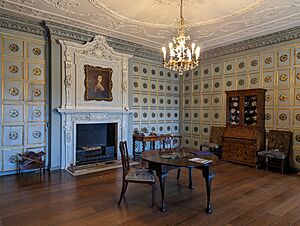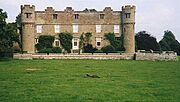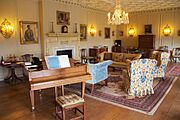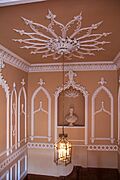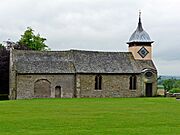Croft Castle facts for kids
Quick facts for kids Croft Castle |
|
|---|---|

Croft Castle in 2010
|
|
| Type | Country house |
| Location | Croft, Herefordshire |
| Built | 16th-20th centuries with earlier additions |
|
Listed Building – Grade I
|
|
| Official name: Croft Castle | |
| Designated | 8 November 1956 |
| Reference no. | 1166451 |
|
Listed Building – Grade I
|
|
| Official name: Church of St Michael | |
| Designated | 11 June 1959 |
| Reference no. | 1166506 |
|
Listed Building – Grade II
|
|
| Official name: Terrace Wall to South and West of Croft Castle | |
| Designated | 9 December 1986 |
| Reference no. | 1166490 |
|
Listed Building – Grade II
|
|
| Official name: Stable block | |
| Designated | 9 December 1986 |
| Reference no. | 1082080 |
| Official name: Croft Castle Park and Garden | |
| Designated | 28 February 1986 |
| Reference no. | 1000878 |
| Lua error in Module:Location_map at line 420: attempt to index field 'wikibase' (a nil value). | |
Croft Castle is a large country house located in the village of Croft, in Herefordshire, England. The Croft family has owned this castle and its land for a very long time, since 1085! Although it left their hands for a while in the 1700s, the family bought it back in 1923. In 1957, the castle was given to the National Trust, an organization that protects historic places. Croft Castle is a very important building, listed as Grade I, which means it has special historical or architectural value.
Contents
History of Croft Castle
A building has stood on this spot since around 1085. This is when the Croft family first settled here. Since then, it has been the home of the Croft family and their descendants, the Croft baronets. The Croft family was closely connected to their neighbors, the Mortimers. A famous battle, the Battle of Mortimer's Cross, happened on Croft land nearby in 1461.
One important family member was Sir John de Croft. He married Janet, one of the daughters of Owain Glyndŵr, a famous Welsh leader. Because of this connection, the Croft family started using a Welsh symbol, the Wyvern crest. This crest shows a wounded black dragon, which was a nod to their Welsh heritage. The very first Croft family member mentioned as owning the estate was Bernard de Croft. He is listed in the Domesday Book, a huge survey of England from 1086.
Changes Over Time
The Croft family faced money problems in the 1700s. In 1746, they sold the estate to Richard Knight. He came from a very rich family who made their money from ironworks. In the 1760s, the castle was updated by Thomas Johnes, who had married Richard Knight's daughter. He gave the castle a new look, called the Rococo-Gothic style. This style made the castle look like an old Gothic building but with fancy, curvy decorations. Old windows were replaced with modern sash windows. Thomas Pritchard, an architect, designed new plasterwork ceilings and a Gothic staircase.
Croft Castle was sold again in 1799 to Somerset Davies. His family later sold it back to Katherine, Lady Croft, in 1923. The castle had more changes in 1913. An architect named Walter Sarel removed part of the old entrance. He added a new entrance with a battlemented porch and a bay window. A battlemented porch looks like it has small walls with gaps, like a castle wall. The entrance hall was decorated with oak wood panels. Many of the old castle-like decorations, called crenellations, were also removed from the roof edges.
In 1937, an older part of the house, built in the 1600s, was taken down. This made the house smaller and easier to manage.
Saving Croft Castle
By 1957, many large country houses in England were being torn down. Diana Uhlman, who was a member of the Croft family, was determined to save Croft Castle. The family worked together to raise money. This money helped the National Trust agree to take care of the house and its land. The castle opened to the public in 1960. Michael, Lord Croft, found paintings and furniture to display. His sister Diana also helped set up a special fund to support the castle. Today, members of the Croft family still live in parts of the house.
Famous Croft Family Members
Many interesting people have been part of the Croft family, including:
- Sir Richard Croft (1429/30-1509): He worked for several English kings.
- Sir James Croft (c.1518–1590): He was an important official for Queen Elizabeth I.
- Herbert Croft (1603–1691): He was a bishop and chaplain to King Charles I.
- William Croft (c.1678–1727): A well-known organist and composer.
- Sir Richard Croft, 6th Baronet (1762–1818): A doctor.
- Henry Page Croft, 1st Baron Croft (1881–1947): A soldier and politician.
Architecture and Design
The castle you see today was mostly built in the 1660s. It replaced an older house that was about 30 yards to the west. Croft Castle is a stone building shaped like a square around a central courtyard. It has round towers at each corner. Some of the original stone windows, called mullion windows, are still there. The castle is one of the first examples of buildings designed to look like medieval castles again.
Special Listings
Croft Castle is a Grade I listed building. This means it is considered a building of exceptional interest. Other parts of the estate are also listed:
- The stable block and some walls are listed as Grade II.
- Three other buildings on the estate, including a Gothic-style pumphouse, Croft Lodge, and Cock Gate Cottage, are also Grade II listed.
- The Church of St Michael is also a Grade I listed building.
- The gardens and parkland around the castle have their own special listing as Grade II*.
Garden and Parkland
The castle has a beautiful three-acre walled garden. There is also a stable block built in the Georgian style. You can see an avenue of Sweet Chestnut trees that were planted over 400 years ago! Beech and oak trees also line the main drive.
The Fishpool Valley was designed in the 1700s. It has ponds that flow downhill, a grotto (a small cave-like structure), a Gothic pumphouse, an ice house (used to store ice before refrigerators), and a lime kiln. This valley has been carefully restored to look as beautiful as it once did.
Church of St Michael
The Church of St Michael dates back to around the 1300s. Inside, you can see wooden box pews from the 1600s and some medieval floor tiles. There is also a beautiful tomb for Sir Richard and Eleanor Croft. The ceiling above the altar, from the 1600s, is painted with clouds and golden stars.
Croft Ambrey Hill Fort
The parkland around the castle includes an Iron Age hill fort called Croft Ambrey. An Iron Age hill fort was a large, fortified settlement built on a hill, used for defense by people living thousands of years ago.
Location of Croft Castle
Croft Castle is located in the area of Croft and Yarpole. It is about 5 kilometers (3 miles) northwest of Leominster, in Herefordshire, England. The castle is surrounded by 1,500 acres of woods, farms, and parkland. A long walking path called the Mortimer Trail also passes by the castle.
Gallery


